1. Background of Asset Tokenization
1. RWA from the Crypto Perspective
2. RWA from the TradFi Perspective
2. How is RWA Disrupting Traditional Finance?
1. Market Accessibility Aids Diversification of Investment Strategies
2. Enhancing Liquidity and Price Discovery
3. Improving Market Efficiency and Reducing Costs
4. Traceability and Programmability
3. Classification of RWA Projects and Representative Project Operation Mechanisms
1. Institutional-Level Permissioned Blockchain Project: Polymesh Private
2. Stablecoin Tokenization Projects: The Overlooked RWA
3. Real Estate Tokenization: Propy's Beneficial Attempt at the Future of Real Estate
4. Tokenized Securities Market: Optimistic Growth Prospects, but Still Facing Some Limitations
5. Carbon Credit Tokenization: Toucan Holds 85% of the Industry Share
6. Art and Collectibles Tokenization: Crypto Punks Spark the Tokenization of Collectibles
7. Precious Metals: PAXG Addresses Common Challenges in Traditional Gold Investment
4. Is the Narrative of RWA Too Optimistic?
1. Regulatory and Compliance Issues
2. Underlying Blockchain Technology
3. Difficulty Distinguishing Hype from Reality
Preface
Since its inception, the total market capitalization of cryptocurrencies has surpassed a trillion dollars, with Bitcoin and Ethereum accounting for over 50% of the market share. However, mainstream asset classes and commodities, whether it be futures gold or the stock market, have market capitalizations that far exceed the total market capitalization of cryptocurrencies.
Against this backdrop, the concept of "RWA" has gained traction in the crypto space since 2023. RWA (Real World Asset) refers to the tokenization of real-world assets and their introduction into the blockchain space, such as commercial real estate, bonds, cars, and almost any asset that can store value and be tokenized. This allows for the storage and transfer of assets without a central intermediary, enabling value to be reflected on the blockchain for trading and circulation. While "RWA" holds great potential for expanding the ceiling of cryptocurrency's total market capitalization, its definition, advantages, and development trends require exploration.
Figure 1: Tokenizable Real World Assets
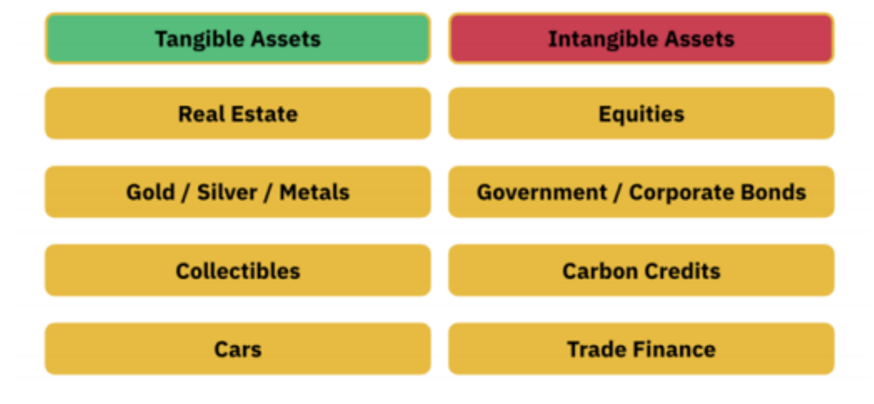
Source: Binance Research
On one hand, some argue that RWA is merely market hype that cannot withstand in-depth scrutiny; on the other hand, there are those who are confident in RWA and optimistic about its future.
This article aims to share perspectives on RWA to facilitate a deeper discussion and analysis of its current state and future.
Core viewpoints are as follows:
The future development direction of RWA should be a bidirectional journey between the real world and the virtual world: specifically, it will involve a new financial system utilizing DLT technology deployed on permissioned chains across multiple jurisdictions and regulatory frameworks.
A calm approach to RWA: The RWA industry needs to cool down from the current hype and view the tokenization of assets rationally. Not all assets are suitable for RWA; some assets that are unpopular in the real world may not be welcomed by the market even after being transformed into RWA.
Many countries around the world are actively promoting legal and regulatory frameworks related to blockchain. Meanwhile, blockchain infrastructure, such as cross-chain protocols, oracles, and various middleware, is rapidly being improved.
The principles and challenges faced by RWA projects for different underlying assets are quite similar, but they have their own solutions and focuses in specific operational mechanisms. For example, while both are security tokens, bond tokens that are often held to maturity typically do not require the same level of liquidity as stock tokens.
1. Background of Asset Tokenization
Asset tokenization refers to the process of recording ownership of a specific asset onto a digital token that can be held, bought, and traded on a blockchain. The resulting tokens represent ownership shares of the underlying asset. In theory, any asset can be digitized, whether it is a tangible asset like real estate or an intangible asset like company stock. Transforming these assets into digital tokens makes them easier to divide, enabling fractional ownership and allowing more people to participate in investment, which in turn can make the market for these assets more liquid. Asset digitization also allows traditional assets to be traded directly on peer-to-peer platforms without intermediaries, bringing greater security and transparency to the market. The basic principles of asset tokenization are as follows:
Acquisition of assets in the real world
Tokenization of these assets on-chain
Distribution of RWA to on-chain users
Figure 2: Tokenization Process
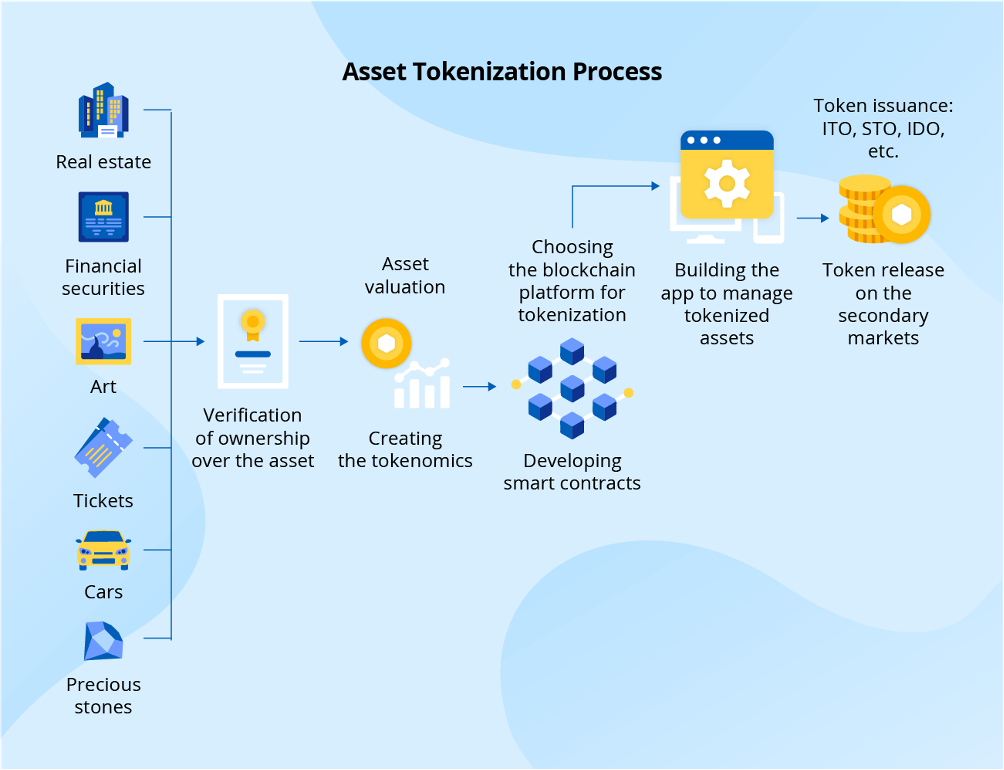
Source: https://www.scnsoft.com/blockchain/asset-tokenization
RWA is not a new concept. As of 2023, the current market size for asset tokenization is estimated to be around $600 billion. Driven by advancements in blockchain technology and the increasing demand for liquidity across various asset classes, this market is expected to grow at a compound annual growth rate (CAGR) of 40.5% from 2024 to 2032. RWA tokens are the fastest-growing asset class among decentralized finance (DeFi) tokens.
Figure 3: Global RWA Market
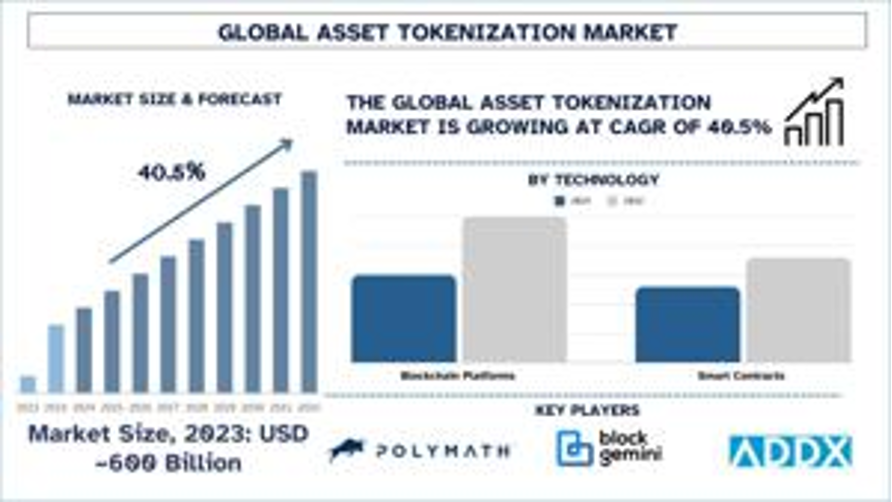
Source: https://www.scnsoft.com/blockchain/asset-tokenization
Although the RWA market is still in its early stages of development, it is experiencing significant growth, and an increasing number of RWAs are being adopted in Web3 protocols. As of November 25, 2024, data from the DefiLlama platform shows that the total value locked (TVL) in RWA token assets has reached $6.512 billion. TVL measures how much cryptocurrency is locked in DeFi protocols, and its increase indicates the recognition and liquidity of token assets in the Web3 world.
Figure 4: The TVL of RWA Token Assets has Reached $6.512 Billion
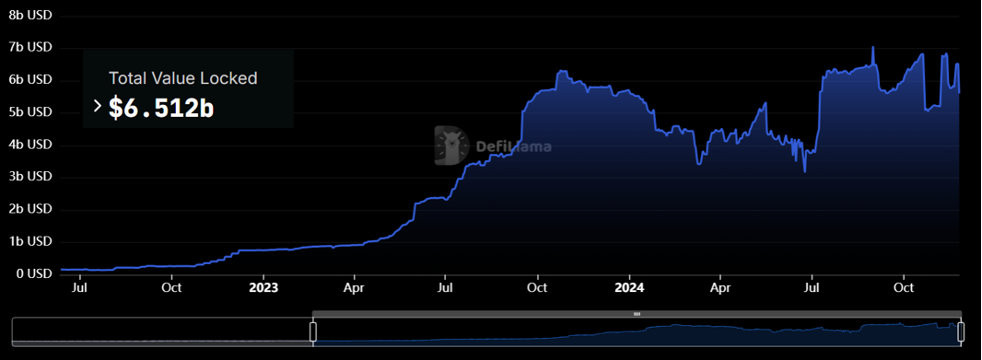
Source: DefiLlama platform
Currently, there are two distinctly different groups regarding the understanding of RWA tokenization, which this article refers to as RWA from the Crypto perspective and RWA from the TradFi perspective. The focus of this article is on RWA from the TradFi perspective.
1. RWA from the Crypto Perspective
The traditional DeFi space has been striving to generate yields, but the underlying yield generation mechanism of DeFi only works effectively when prices are rising. In the context of a crypto winter, the stagnation of on-chain activity has directly led to a decline in on-chain yields. The drop in TVL in DeFi protocols from $180 billion at the market peak to $50 billion best reflects the unsustainable yield model. As yields plummeted, the pursuit of "real yields" intensified, prompting DeFi protocols to integrate RWA tokens as a more stable source of income. This is why on-chain U.S. Treasury bonds have become the hottest track recently.
Thus, RWA from the Crypto perspective can be summarized as the crypto world's one-sided demand for the yield of real-world financial assets, primarily against the backdrop of the Federal Reserve's continuous interest rate hikes and balance sheet reductions, which have led to a steady, slight increase in U.S. Treasury yields while extracting liquidity from the crypto market, causing DeFi market yields to decline. The most notable example is MakerDAO's announcement to invest its $1 billion reserves in tokenized U.S. Treasury products.
Figure 5: The Market Value of Tokenized U.S. Treasury Bonds is $603 Million
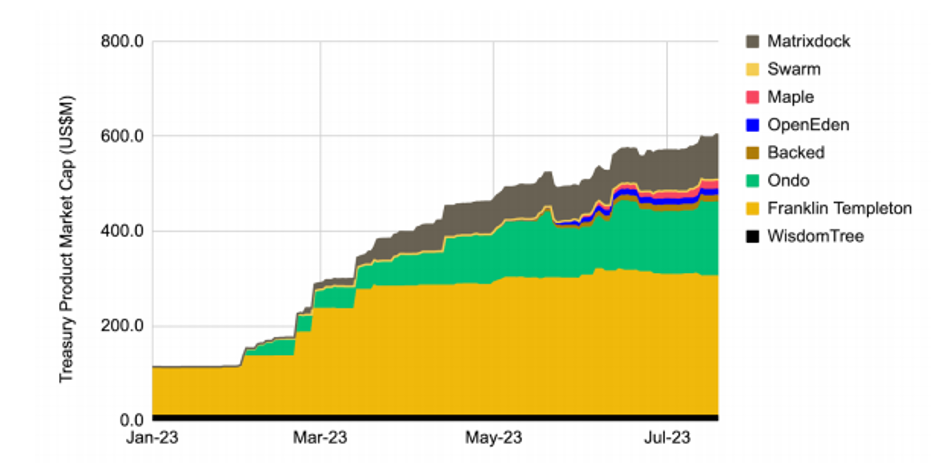
Source: Binance Research
The significance of MakerDAO purchasing U.S. Treasury bonds lies in the ability of DAI to diversify the assets it supports through external credit, and the long-term additional yields from U.S. Treasury bonds can help stabilize DAI's exchange rate, increase the flexibility of issuance, and reduce DAI's dependence on USDC by incorporating U.S. Treasury bonds into its balance sheet. Additionally, by investing in tokenized U.S. Treasury bonds, MakerDAO can obtain a stable source of income. In fact, MakerDAO has recently shared part of its U.S. Treasury bond earnings, raising DAI's interest rate to 8% to boost demand for DAI, which has also led to a 5% increase in the price of Maker's governance token, MKR.
2. RWA from the TradFi Perspective
From the perspective of crypto tokens, RWA primarily expresses the crypto world's one-sided demand for the yield of traditional financial world assets, merely seeking a new sales channel for assets. However, from the traditional finance (TradFi) perspective, RWA represents a bidirectional journey between traditional finance and decentralized finance (DeFi). RWA not only introduces value to the cryptocurrency market but also empowers real assets with the advantages of cryptocurrencies.
For the traditional financial world, DeFi financial services that are automatically executed based on smart contracts are an innovative fintech tool. RWA in the TradFi space focuses more on how to combine DeFi technology to achieve asset tokenization, thereby empowering the traditional financial system. Specifically:
Improving Transaction Efficiency: RWA can transfer multiple stages in traditional IPOs (such as service providers, brokers, custodians, etc.) onto the blockchain, completing transactions in one go, avoiding cumbersome processes between different locations and entities, and not being restricted by exchange hours, thus supporting direct transactions between crypto wallets.
Reducing Financing Costs: Through Security Token Offerings (STOs), RWA can provide financing for some less popular industries, lowering investment banking fees (from 5-6% to 3%), attracting projects that struggle to obtain loans due to banks' disinterest (e.g., the financing difficulties faced by small and medium-sized enterprises), helping them find interested investors.
Simplifying Investment Barriers: RWA allows users to invest in global stocks, real estate, and other assets with just one account, solving the problem of needing multiple accounts when purchasing financial products across platforms, thereby lowering the barriers and complexity of investment.
This article argues that distinguishing the logic of RWA is necessary. The underlying logic and implementation paths of RWA differ significantly depending on the perspective. First, in choosing the type of blockchain, the two have different implementation paths. Traditional finance's RWA follows a permissioned chain path, while the crypto world's RWA is based on a public chain path.
Due to the characteristics of public chains, such as no entry requirements, decentralization, and anonymity, RWA in crypto finance faces significant compliance obstacles, and technical vulnerabilities or smart contract flaws in public chains may lead to asset loss or transaction failure for users. Therefore, public chains may not be suitable for the tokenization and trading of a large number of real-world assets. In contrast, permissioned chains allow only authorized participants to access the network, ensuring that only compliant financial institutions, regulatory bodies, and other relevant parties can participate in transactions and data access, providing a basic prerequisite for legal compliance across different countries and regions. Additionally, unlike public chains, assets issued by institutions on permissioned chains can be native on-chain assets rather than mapped to off-chain assets that already exist, which presents enormous transformative potential for RWA in native on-chain financial assets.
Figure 6: Different Access Barriers for Public and Private Chains
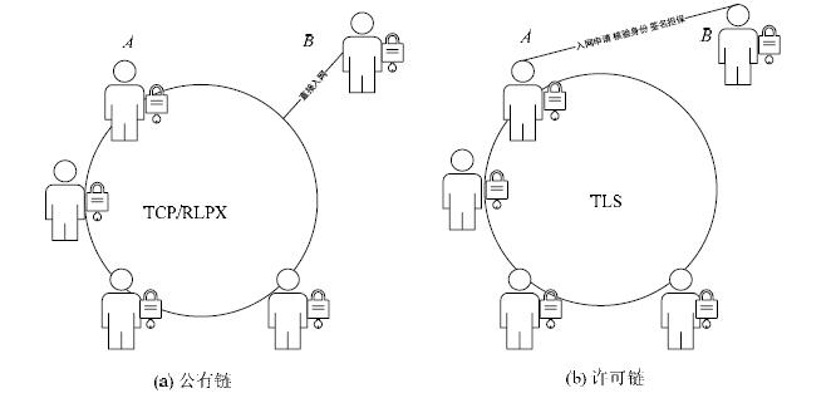
Source: https://www.jos.org.cn/html/2019/6/5743.htm
In summary, the future development direction of RWA should be a bidirectional journey between the real world and the virtual world: specifically, it will involve a new financial system utilizing DLT technology deployed on permissioned chains/private chains across multiple jurisdictions and regulatory frameworks.
2. How is RWA Disrupting Traditional Finance?
In the traditional financial system, assets such as stocks, bonds, and real estate typically exist in the form of paper certificates, which are then transformed into digital records held by centralized financial institutions. These records encompass ownership, liabilities, conditions, and contracts, and they are often scattered across independently operated different systems or ledgers. These institutions maintain and verify financial data, allowing people to trust the accuracy and completeness of this data. However, since each intermediary holds different pieces of the puzzle, the financial system requires extensive post-factum coordination to reconcile and settle transactions, ensuring the consistency of all relevant financial data. It is easy to see that this traditional system faces numerous challenges:
- High transaction costs due to multiple intermediaries (including brokers and custodians).
- Extended settlement times, especially for cross-border transactions, which often take several days to complete.
- Limited investment opportunities, where only high-net-worth individuals and institutional investors can participate in certain asset classes.
Blockchain, as a distributed ledger technology, demonstrates enormous potential in addressing the efficiency issues commonly found in traditional financial systems. It directly resolves the information fragmentation caused by multiple independent ledgers by providing a unified, shared ledger, significantly enhancing the transparency, consistency, and real-time updating capabilities of information. The application of smart contracts further enhances this advantage, allowing transaction conditions and contracts to be encoded and automatically executed when specific conditions are met, significantly improving transaction efficiency and reducing settlement times and costs, especially in scenarios involving complex multi-party or cross-border transactions. Therefore, for the traditional financial system, the significance of RWA lies in creating digital representations of real-world assets (such as stocks, financial derivatives, currencies, rights, etc.) on the blockchain, extending the benefits of distributed ledger technology to a wide range of asset classes for exchange and settlement. A study conducted by BNY Mellon in 2022 indicated that tokenized products are very popular among institutional investors. After surveying 271 institutional investors, BNY Mellon found that over 90% of respondents expressed interest in investing in tokenized products, and 97% agreed that "tokenization will fundamentally change asset management" and "is beneficial for the industry." The benefits of tokenization include eliminating friction in value transfer (84%) and increasing access for the general public and retail investors (86%).
Figure 7: Different Access Barriers for Public and Private Chains
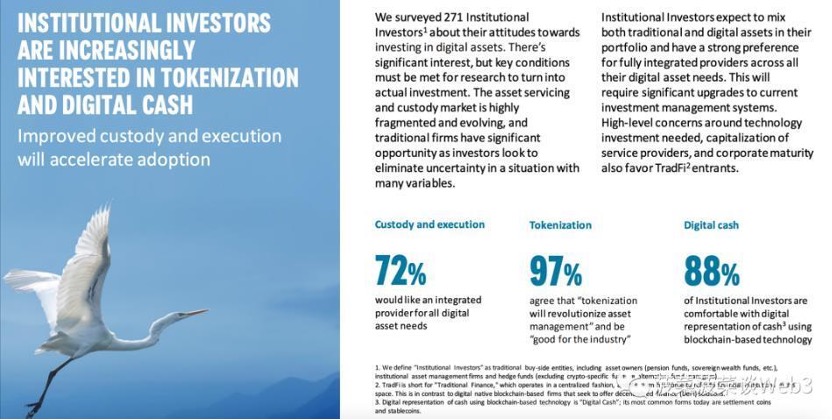
Source: https://www.bny.com/corporate/global/en.html
To delve deeper into the transformative power of RWA on the traditional financial system, here is a more detailed analytical framework:
1. Market Accessibility Aids Diversification of Investment Strategies
Tokenization achieves fractional ownership by breaking down high-value assets (such as real estate and art) into tradable tokens, enabling small investors to participate in markets that were previously inaccessible due to high costs, thereby democratizing investment opportunities.
Imagine traditionally illiquid assets, such as a house, which can be fragmented and sold through tokenization, allowing real estate investors from other countries to participate. These assets can be actively traded in the market, enabling investors to convert their assets into cash more quickly. The tokenization process is akin to turning these assets into commodities that can be bought and sold at any time, greatly enhancing trading efficiency.
Additionally, unlike the specific trading hours of traditional financial markets, tokenized RWAs can be traded on blockchain platforms around the clock, providing more opportunities for cross-time-zone trading and thus increasing liquidity.
“Tokenization allows for fractional ownership of assets, providing opportunities for small investors, with blockchain as the driving force. This is a win-win situation where more people can access high-value investments, while institutions can tap into new revenue sources,” said a participant at the 2023 Hubbis Token Digital Asset Forum in Singapore.
2. Enhancing Liquidity and Price Discovery
Tokenization reduces the friction associated with the sale, transfer, and record-keeping of assets, enabling previously illiquid assets to be traded seamlessly at almost zero cost. In traditional financial markets, the transfer of assets often involves multiple intermediaries, leading to complex and time-consuming transaction processes. For example, in the case of rare gems or private equity, investors faced significant challenges in trading positions in these asset classes, often spending considerable time and effort to find buyers or sellers. Tokenization leverages the decentralized nature of blockchain to simplify this process, allowing buyers and sellers to transact directly and reducing transaction costs. With blockchain technology, investors no longer have to wait months or years to find suitable buyers; they can quickly transfer assets to other investors when needed, thereby providing secondary market liquidity in a secure and compliant manner.
At the same time, buyers and sellers can trade more easily and price based on new relevant information. This transparency and real-time nature enable market participants to better assess the value of assets, leading to more informed investment decisions.
Figure 8: Tokenization Enables Illiquid Assets to Trade Seamlessly at Almost Zero Cost
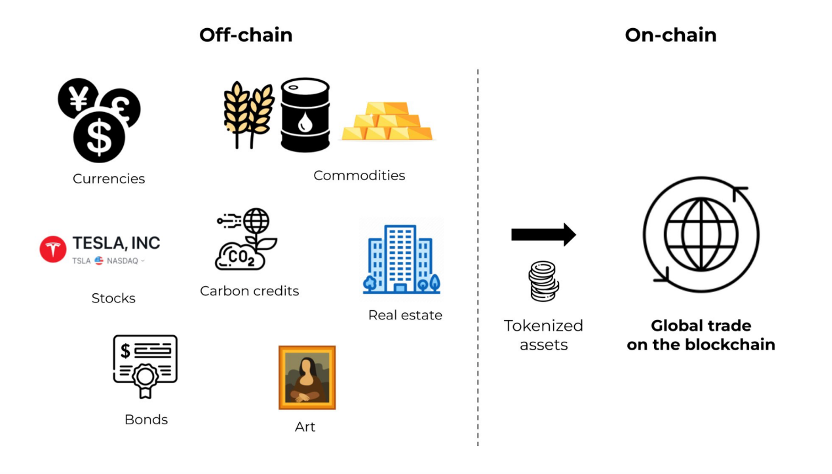
Source: https://blog.defichain.com/unlocking-real-world-value-what-are-real-world-assets-and-why-do-they-matter-in-defi/
3. Improving Market Efficiency and Reducing Costs
In various aspects of human daily life, financial activities, and trade activities, clearing and settlement are ubiquitous. For users, it may seem like a simple payment action has transferred money, but in reality, this simple payment action involves many clearing and settlement processes behind the scenes.
Figure 9: The Clearing and Settlement Process
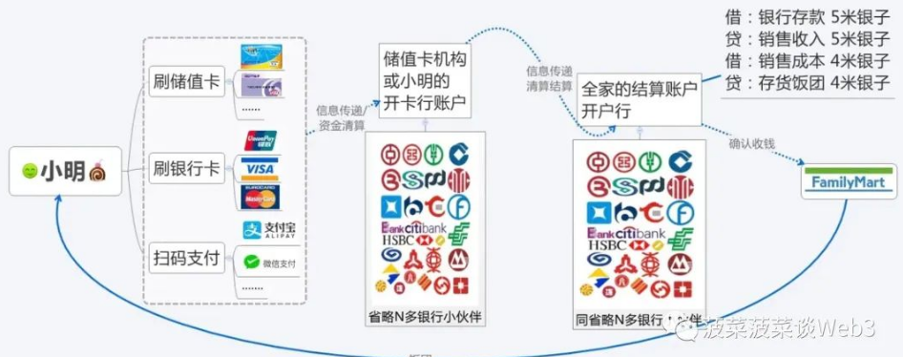
Source: https://www.woshipm.com/pd/654045.html
As shown in the figure, in the traditional financial system, clearing and settlement is a "computational" process of accounting and confirmation. Parties reach a consensus through continuous verification and validation, and based on this, asset transfers occur. This process requires collaboration among multiple financial sectors and incurs significant labor costs, while also facing risks of operational errors and credit risks. For example, the collapse of Herstatt Bank on June 28, 1974, exposed the credit risks of cross-border payments and their potential for significant destruction.
Blockchain eliminates many intermediaries by adopting distributed ledgers and automated smart contracts, enabling 24/7 payments, instant receipts, and easy withdrawals, while smoothly meeting the convenience needs of cross-border e-commerce payment settlement services. Since assets can autonomously transfer between parties through smart contracts and are stored in an immutable ledger, it establishes a global integrated cross-border payment trust platform at a lower cost, alleviating the financial risks posed by cross-border payment fraud.
The Mariana Project, a collaboration between the Bank for International Settlements Innovation Hub (BISIH), the Bank of France, the Monetary Authority of Singapore (MAS), and the Swiss National Bank, released a test report on September 28, 2023, successfully validating the technical feasibility of using automated market makers (AMMs) for international cross-border transactions and settlements of tokenized central bank digital currencies (CBDCs).
Figure 10: The Mariana Project Validated the Technical Feasibility of International Cross-Border Transactions and Settlements
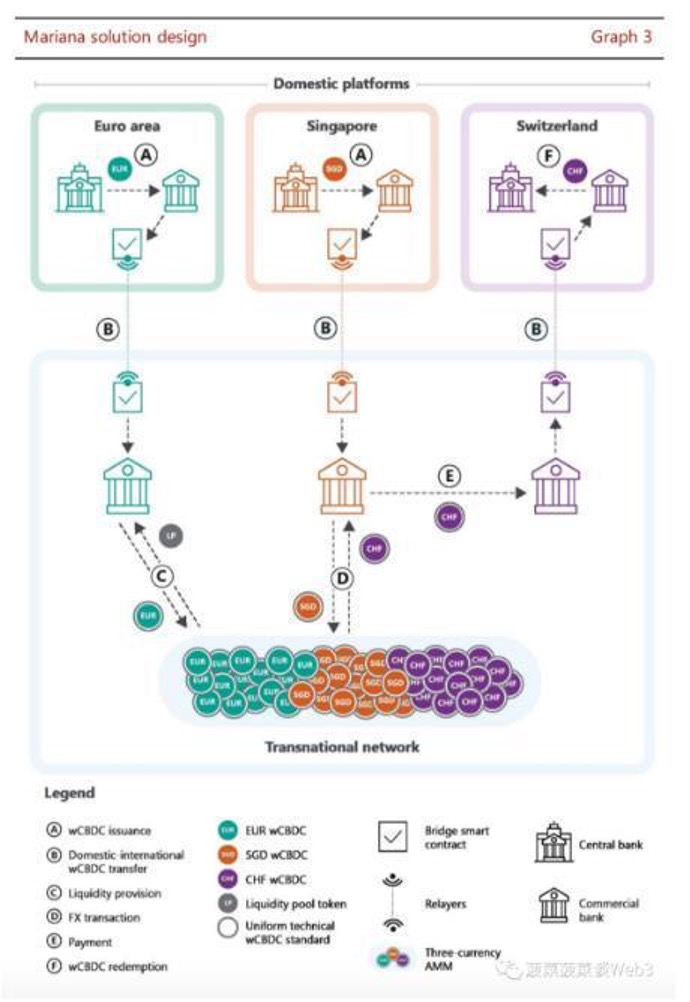
Source: https://www.bis.org/publ/othp75.html
4. Traceability and Programmability
The 2008 financial crisis is a classic case of a global financial disaster triggered by financial derivatives. In this crisis, financial institutions packaged subprime mortgages into securities (such as mortgage-backed securities (MBS) and collateralized debt obligations (CDOs)) and sold them to investors, creating complex financial products that made it impossible to trace the underlying real assets. These layered and packaged derivatives were sold to various brokers and investors, leading to a rapid increase in leverage across the financial system, ultimately igniting the financial tsunami.
Imagine if RWA (Real World Assets) technology had been applied in 2008; investors would have been able to trace the underlying assets of these financial instruments, allowing them to trade with a full understanding of asset risks. This transparency would fundamentally change the way asset management and trading are conducted. Through blockchain technology, every transaction is recorded on an immutable ledger, providing clear and auditable records of ownership and transfers. This not only significantly reduces the risks of fraud and mismanagement but also enables regulators to more easily track activities, ensuring trust between financial institutions and their clients.
Another example demonstrating how programmability and traceability benefit the traditional financial system is the "Digital Invoice Tokenization" project by Australian startup Unizon. Small and medium-sized enterprises often find themselves in a dilemma regarding the authenticity of invoices: if they cannot accept delayed payments, it is challenging to secure orders from large enterprises; yet accepting orders from large enterprises may lead to tight liquidity and increase the risk of cash flow disruptions. Unizon's project creates two accounts through ERC-3525: a payable account and a receivable account. A payment channel similar to quantum entanglement is formed between these two accounts; as soon as the buyer remits to the payable account, the funds are automatically distributed to the receivable account via smart contracts.
Figure 11: Unizon's "Digital Invoice Tokenization" Project
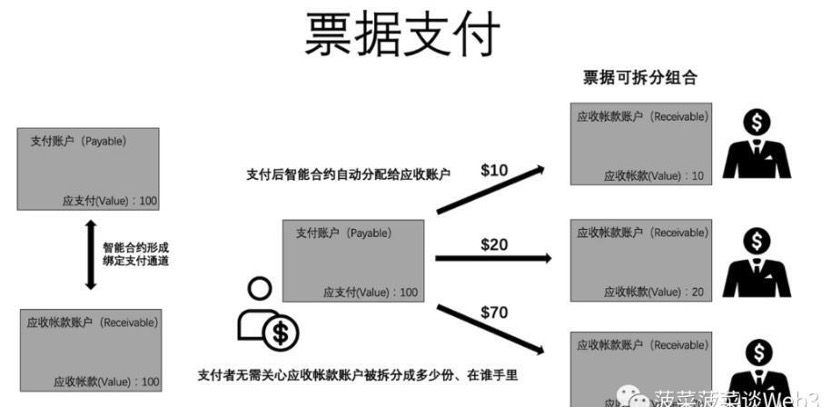
Source: https://mirror.xyz/bocaibocai.eth/q3s_DhjFj6DETb5xX1NRirr7St1e2xha6uG9x3V2D-A
By converting invoices into digital tokens, Unizon can achieve rapid transfer and trading of invoices. This tokenization transforms invoices from mere paper documents into digital assets that can be managed on the blockchain. Furthermore, all invoice transaction records will be recorded on the blockchain, ensuring transparency and immutability of information.
Three, Classification of RWA Projects and Representative Project Operation Mechanisms
RWA projects mainly involve infrastructure projects for RWA and RWAs belonging to specific asset categories.
Infrastructure projects mainly include:
Layer 1 blockchains: such as the institution-level permissioned blockchain Polymesh, built specifically for RWA tokens; the MANTRA token Chain, based on the Cosmos token SDK, which allows users to issue and trade RWA tokens; and the Ondo token Bridge, which enables native cross-chain transfers of RWA tokens.
Tokenization platforms: such as the decentralized finance platform Centrifuge, which aims to provide financing solutions for small and medium-sized enterprises.
Identity: such as SprucelD and Quadrata, which address decentralized identity issues.
Figure 12: RWA Tokenization Ecosystem Map
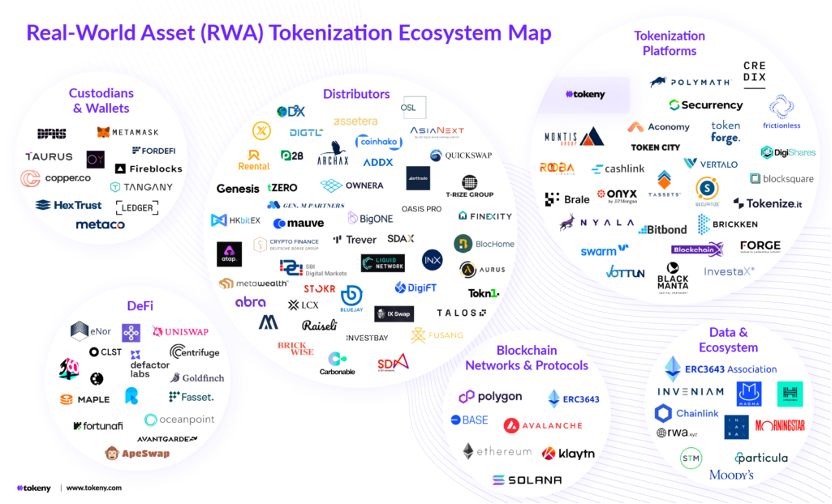
Source: https://tokeny.com/real-world-asset-rwa-tokenization-ecosystem-map/
In theory, all assets can be put on-chain and tokenized. Through tokenization, these assets can be divided into smaller shares, lowering investment barriers, increasing liquidity, and providing higher transparency and security through blockchain technology, thereby attracting more investors to participate.
Figure 13: Multiple RWA Protocols Across Various Asset Classes Have Emerged

Source: Nansen, Root Data, crypto.com Research
1. Institution-Level Permissioned Blockchain Project: Polymesh Private
Ethereum established a foundational layer for security tokens—smart contracts—making tokens programmable and automated. So why do we need to build dedicated blockchains in the future? As mentioned earlier, public chains, with their lack of entry requirements, decentralization, and anonymity, clearly cannot meet the compliance and regulatory requirements of RWA. We need more foundational layers to ensure regulatory compliance and institutional confidence.
The Polymesh Association announced the launch of Polymesh Private at the 2024 Digital Assets Summit: this is a new complementary version of the public permissioned blockchain token Polymesh, bringing enhanced confidentiality and control to the infrastructure built specifically for regulated assets. Polymesh Private is particularly targeted at the institutional finance sector, including banks and large financial institutions. It addresses common concerns regarding public network visibility and compliance with regulatory frameworks, making it an ideal choice for organizations that require a secure and controlled tokenization environment. It shares core infrastructure with the public permissioned blockchain Polymesh but is built on three core elements that distinguish it from public blockchains:
Operational Control: The operating entity has complete autonomy over the blockchain environment, including who can participate, whether to include network tokens, network fees, block size, and transaction speed. This flexibility ensures that the blockchain can be customized according to specific business needs and seamlessly collaborate with operational goals without encountering issues related to scalability, throughput, or compliance.
Privacy: Unlike public blockchains where transaction details are visible to everyone, Polymesh Private employs advanced encryption technologies to ensure that transaction amounts, account balances, and asset types remain confidential, with only relevant parties able to decrypt sensitive information.
Public Compatibility: Polymesh Private operates on the same architecture as Polymesh, allowing users to enjoy the development, new features, and versions of the public network as needed. This compatibility provides enterprises with the flexibility to transition to public infrastructure when ready, ensuring that financial institutions can fully leverage the advantages of both private and public blockchain technologies as demand evolves. This is a significant advantage in fast-paced, rapidly changing technological industries.
Figure 14: Polymesh Private is an Institution-Level Permissioned Blockchain Project
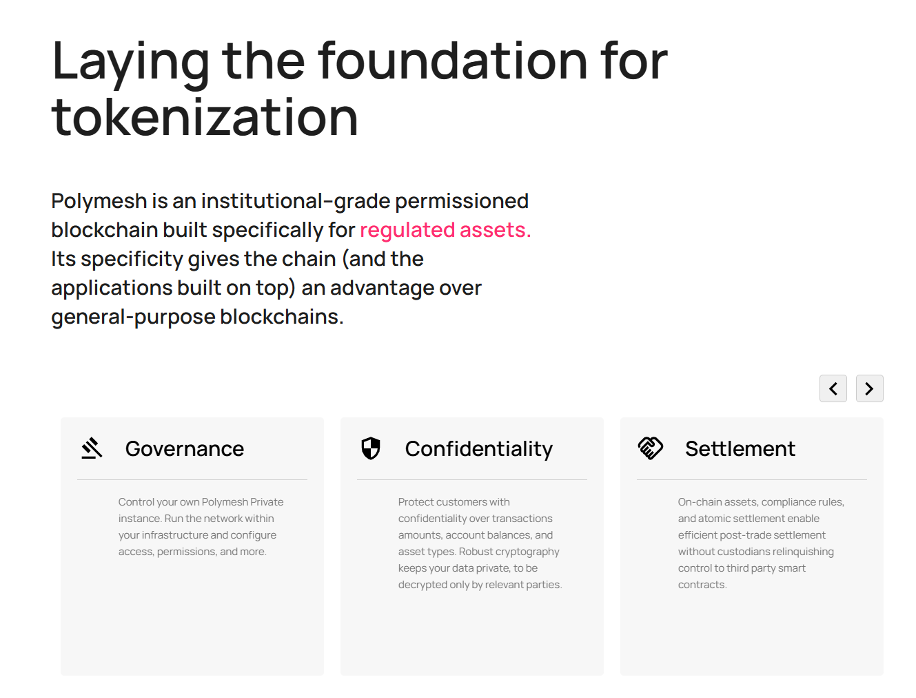
Source: https://polymesh.network/private
According to four independent third-party audit reports, the Polymesh public network has been operational for over two years without any security incidents. The Polymesh mainnet has also been upgraded to version 7.0, introducing new features, updates, and performance improvements. Users of Polymesh Private can benefit from the ongoing development of the public Polymesh infrastructure, which is carried out by the Polymesh Association and the broader community.
However, it is important to note that while Polymesh Private is designed to be compatible with the public Polymesh network, achieving complete interoperability in practice may face technical barriers. Ensuring seamless migration and communication between private and public networks remains an ongoing challenge. Additionally, while Polymesh Private aims to serve enterprise-level users, its performance and scalability have not been fully tested in large-scale deployments. As the number of users increases, questions about the network's performance and its ability to handle a large volume of transactions still need further validation.
2. Stablecoin Tokenization Projects: An Often Overlooked RWA
According to the definition of real-world assets, centralized stablecoins may be the earliest and largest scale of RWA, yet they are often overlooked. The market capitalization of stablecoins has significantly increased since 2020, growing from $5 billion to $180 billion, although they only account for about 5.58% of the total cryptocurrency market capitalization of $3.35 trillion. As of November 26, 2024, the total market capitalization of stablecoins is estimated to be $187.38 billion, with Tether (USDT) being the largest stablecoin, valued at $135.05 billion, accounting for 72.07% of the total stablecoin supply. Issuers of stablecoins like Tether and Circle back their stablecoins with fiat currency or cash equivalents, providing a price-stable medium of exchange for the crypto world while also earning returns through held bonds, making stablecoins a foundation of the crypto market.
Figure 15: Polymesh Private is an Institution-Level Permissioned Blockchain Project
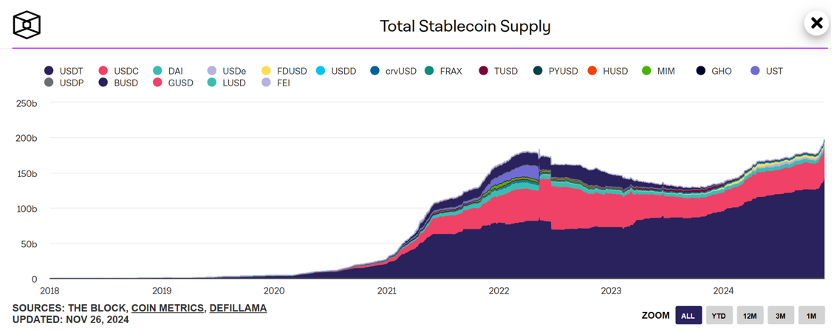
Source: https://www.theblock.co/data/stablecoins/usd-pegged/total-stablecoin-supply, the supply shown in this chart includes the currently held but unissued USDT in the Tether treasury.
In the DeFi space, over 75% of DeFi transactions are conducted using stablecoins. In June 2024, due to the implementation of MiCA regulations, some major exchanges canceled trading of certain well-known stablecoins for European users, but USDC was unaffected, indicating its recognition in regulatory compliance. The stablecoin market is expected to continue growing, but attention must also be paid to regulatory changes and market risks.
3. Real Estate Tokenization: Propy's Beneficial Experiment for the Future of Real Estate
One of the most obvious opportunities in the RWA space is real estate. Ownership, sales, and mortgages of real estate have long been based on rules and regulations set by judges or courts, while intermediaries have made asset transactions cumbersome and introduced additional costs, resulting in real estate being one of the most fragmented and least efficient markets.
By putting real estate assets on-chain, many tasks involved in transactions can be completed autonomously and without restrictions. For example, properties that originally needed to be bought and sold as whole units can be fragmented for sale, allowing ordinary investors to hold fractional ownership for investment, and investors from other countries can also participate. By introducing oracles, real-time market valuation data for real estate can be obtained directly. Furthermore, ownership and transfer records can be recorded seamlessly and economically, eliminating the possibility of fraud and human error.
Figure 16: Development Prospects of the Real Estate Tokenization Market
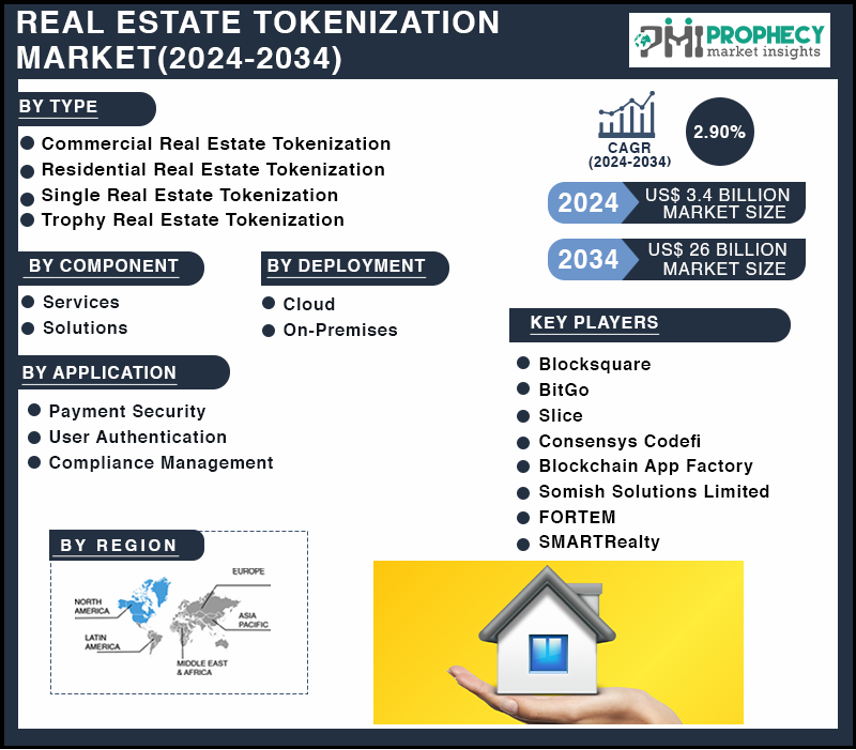
Real estate tokenization projects include global real estate trading platform Propy, real estate tokenization platform ReaIT, real estate trading and leasing platform Atlant, real estate investment platform BlockVenture, which allows enterprises to issue STOs representing real estate token financing, RWA tokenization, and stablecoin lending platform Tangible, among others.
For example, Propy, founded by Natalia Karayaneva in 2016, utilizes blockchain, smart contracts, and cryptocurrency to simplify and revolutionize the buying, selling, management, and trading of real estate. According to its official website, Propy has processed $4 billion in transactions for consumers and agents from companies such as Compass, eXp, The Agency, Redfin, KW, Remax, Realty Austin, and ACME. Key features of Propy include:
- Simplifying the home buying experience through blockchain technology, eliminating fraudulent transactions.
- Providing a decentralized land registration system to record property ownership and title transfers.
- Enabling online processing of real estate purchases, increasing transaction security and transparency.
- Automating transactions through smart contracts and cryptocurrency payment systems.
Propy has three core products: the Propy real estate trading platform, Propy title and escrow services, and PropyKeys.
The Propy real estate trading platform utilizes smart contracts, RWA, and blockchain technology to provide end-to-end property trading services for agents and clients.
Propy title and escrow services are blockchain-based title and escrow services that ensure transaction security while supporting traditional title transfer processes.
PropyKeys, based on the Ethereum Layer 2 network Base, enables the tokenization of real estate. In March of this year, PropyKeys was officially opened to the public. Users can mint and store on-chain addresses corresponding to physical properties and title certificates through the PropyKeys app, thereby earning PRO tokens.
Figure 17: Propy Official Website Promotion

Source: https://propy.com/browse/
Through its three core products, Propy significantly enhances the security and efficiency of real estate transactions by integrating blockchain technology. Additionally, Propy plans to unlock new buying, selling, and investment opportunities through partnerships with REITs, making real estate transactions more widespread and accessible. Propy is also committed to pushing the boundaries of real estate technology through its Web3 portal and Propy Labs, providing better user experiences and community engagement.
Despite the potential advantages of the real estate tokenization concept, there are still many challenges and issues in practical applications. One major issue is geographical limitations: different countries and regions have varying legal regulations, involving multiple legal systems and frameworks, which may lead to compliance issues. Furthermore, the lack of unified regulatory standards affects the legality and feasibility of real estate tokenization projects. Therefore, whether international universal laws for real estate tokenization can be established and enforced will directly impact the future development potential of real estate tokenization.
4. Tokenized Securities Market: Optimistic Growth Prospects, but Still Facing Some Limitations
Tokenized securities refer to the digitization of traditional securities such as stocks or bonds onto blockchain platforms. The market size for tokenized securities reached $20.2 billion in 2023 and is expected to grow to $301 billion by 2030, with a compound annual growth rate of 5.96% during the forecast period.
One significant advantage of the tokenized securities market compared to traditional securities, which often face trading time constraints, is liquidity; tokenized assets can be traded 24/7 across various platforms.
Classified by product/type, the tokenized securities market can be divided into the stock market and the public bond market.
(1) Tokenized Stocks
On-chain stock trading initially existed in the form of synthetic assets, with typical representatives being Synthetix and Mirror Protocol. However, these projects lack real stock backing and face compliance issues, while some compliant projects are currently joining this space.
For example, Backed Finance is a company focused on tokenizing traditional financial assets and has issued various tokenized products, including tokenized stocks and fixed income, with a total issuance exceeding $52.04 million. The tokens issued by Backed are called bTokens, which are 1:1 pegged to physical assets (such as ETFs, government bonds, securities, etc.), allowing investors to hold these assets in tokenized form. According to Backed's official information, the platform has issued eight fixed income products, such as the iShares Short-Term Government Bond ETF, and nine securities products, including Tesla, NVIDIA, Coinbase, MicroStrategy, and the S&P 500 Index ETF.
bIB01: Tracks the price of the iShares tokenized Treasury Bond 0-1yr UCITS ETF.
bC3M: Tracks the price of the Amundi GOVIES 0-6 Months Euro Investment Grade UCITS ETF.
bCOIN: Tracks the price of Coinbase Global stock.
bNVDA: Tracks the price of NVIDIA stock.
Figure 18: Propy Official Website Promotion

Source: https://backed.fi/#
On the technical side, Backed Finance addresses three core issues of tokenized assets—data on-chain, liquidity, and synchronization—through three functional integrations with Chainlink.
Data On-Chain: Tokenized assets typically rely on a large amount of off-chain data, such as market pricing, reference data, and identity information. To ensure that the asset's status is updated in a timely manner and to facilitate transactions, Chainlink Data Feeds can transmit this necessary data to the blockchain, ensuring data accuracy and real-time availability. Additionally, with the reserve proof established by Chainlink PoR, Backed can effectively prevent over-issuance attacks and better manage market risks, liquidity, issuance timelines, and liabilities.
Liquidity: As blockchain technology diversifies, the fragmentation of liquidity between public chains has become increasingly severe, leading to the so-called "liquidity island" dilemma. To meet the needs of traditional financial institutions, tokenized assets must be able to flow seamlessly across multiple blockchains. By integrating Chainlink's CCIP, Backed enables institutional clients to transfer tokens seamlessly between different blockchains and access cross-chain liquidity pools.
Figure 19: Backed Finance and Chainlink Integration Solving Token Liquidity Issues Across Different Blockchains
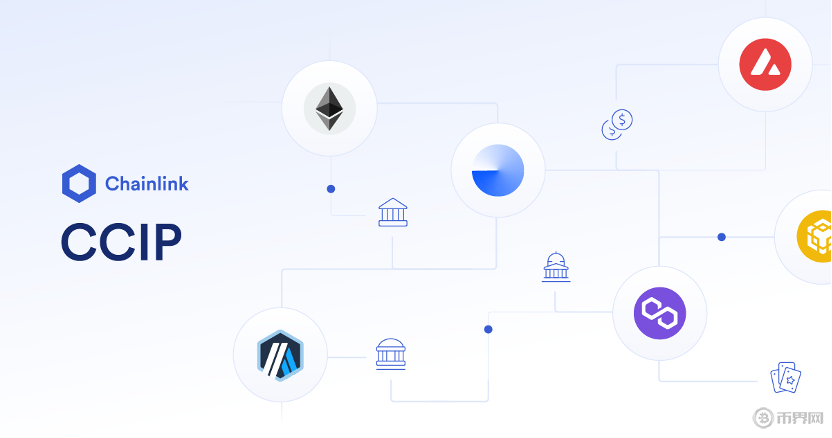
Source: Binance
- Synchronization: Once tokenized assets are deployed across multiple blockchains, ensuring the synchronization of data across different chains becomes a top priority. The synergy between Chainlink's Cross-Chain Interoperability Protocol (CCIP), Proof of Reserve (PoR), and Data Feeds ensures the consistency and connectivity of these critical data points in multi-chain deployments, while guaranteeing the full collateralization and highest security of tokenized assets in a multi-chain environment.
In summary, the collaboration between Backed Finance and Chainlink not only addresses the liquidity island and data synchronization issues in the RWA tokenization process but also provides strong technical support for promoting multi-chain transmission and large-scale adoption of global blockchain assets. The success of this integration may become a classic case in the future of RWA tokenization, leading more innovative applications toward maturity.
(2) Public Bond Market
Tokenized bonds, also known as digital bonds, are a type of debt instrument. Unlike traditional bonds, the issuance and trading of digital bonds do not rely on traditional financial intermediaries but are realized through distributed ledger technology (DLT), particularly blockchain technology.
According to the Hong Kong Monetary Authority (HKMA) in its report on "Tokenization of the Hong Kong Bond Market," as of March 2023, the total issuance of tokenized bonds globally has reached approximately $3.9 billion. In the practice of digital assets and digital bonds, the Hong Kong Special Administrative Region government is at the forefront. In 2023, the Hong Kong SAR government successfully issued a digital bond with a total value of HKD 800 million, which is the world's first government bond with green and digital characteristics. In 2024, Hong Kong will issue another green digital bond worth approximately HKD 6 billion. Both issuances of digital bonds adopted a two-step prudent strategy:
- First, the bonds are deposited in the Central Moneymarkets Unit (CMU) of Hong Kong,
- Second, the bonds are tokenized.
Compared to traditional bond issuance models, the settlement cycle for digital green bonds has been shortened from five working days (T+5) to one working day, reducing issuance time and saving costs. At the same time, DLT can include more information, such as debt terms and environmental benefit data, allowing holders to clearly understand the progress of fundraising projects and the environmental benefits generated by the bonds, which is an advantage difficult to achieve with traditional bonds.
Figure 20: Hong Kong Government Issues Green Bonds
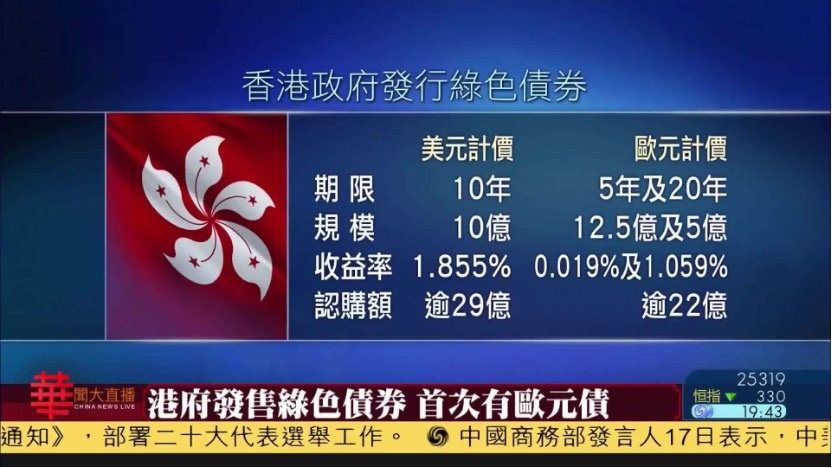
Source: https://travel.ifeng.com/c/8BHEBZ4p1rz
From overseas experience, many fintech platforms under traditional large financial institutions are actively participating in the digital bond market and providing related technical services. For example, HSBC's HSBC Orion, Goldman Sachs' GS DAPTM, and Société Générale's SG-Forge platforms. To address the high investment threshold and cumbersome account opening process for ordinary retail investors in government bonds, Ondo Finance has preliminarily solved the compliance issues of on-chain U.S. Treasury bonds within the existing legal framework in the United States; the bond exchange Bondblox splits bonds and offers smaller denomination bond trading, with a minimum purchase of $1,000, while the corresponding original bond face value may be $200,000.
Figure 21: Benefits of Ondo Tokens
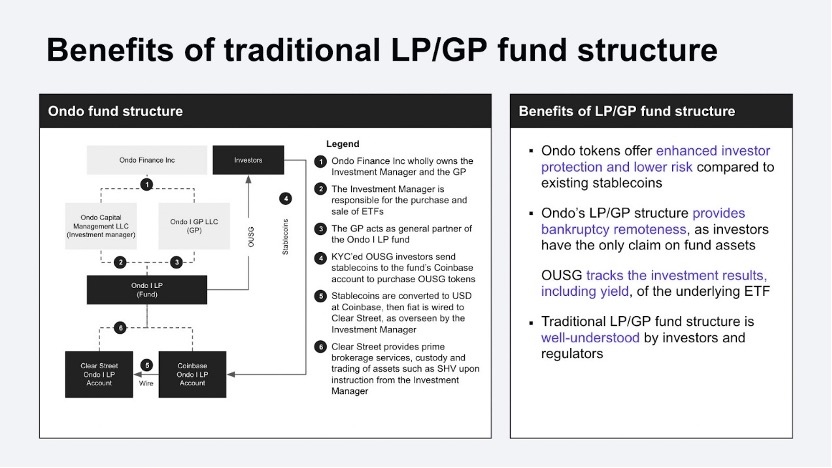
Source: https://www.comp.xyz/t/listing-ousg-tokenized-us-treasuries-from-ondo-finance-on-compound-v3/4772
However, there are also overseas cases indicating that the detachment of digital bonds from business rules and the lack of a sound system may pose risks and create new challenges for investor protection. For instance, in 2018, the World Bank launched the world's first blockchain bond, Bond-I, with the help of the Commonwealth Bank of Australia (CBA-US). However, due to immature technology and restrictions from certain legal compliance regulations, the final issuance amount was less than $10 million, far below expectations.
Despite the optimistic growth prospects, the tokenized securities market still faces some limitations. Regulatory uncertainty in major markets such as the United States and the European Union remains a significant challenge. In particular, the U.S. Securities and Exchange Commission has expressed concerns about the classification and governance of certain digital assets. Additionally, issues related to technological scalability and cybersecurity risks continue to hinder adoption. As the market develops, ensuring that blockchain infrastructure can support high transaction volumes without compromising security remains an urgent issue. According to the Financial Stability Board (FSB), nearly 30% of financial institutions view security and scalability as barriers to the large-scale tokenization of securities.
5. Carbon Credit Tokenization: Toucan Holds 85% of the Market Share
The traditional carbon market is inefficient and flawed in many ways:
Lack of Price Discovery: Most voluntary carbon trading occurs in over-the-counter (OTC) markets, and the value of carbon credits depends on various factors, such as project type, year, or country, making it more difficult to understand the true market price of voluntary carbon credits.
Poor Liquidity: The voluntary carbon market is highly fragmented and lacks liquidity, with the heterogeneity of carbon credits meaning that different types of carbon offsets have low trading volumes.
Lack of Transparency: Since the market is voluntary and not regulated by a single entity, it is difficult, if not impossible, to obtain detailed information about active carbon credit owners and projects.
The tokenization of carbon credits increases market liquidity by introducing new users, and transferring carbon credits to the blockchain will also facilitate improved price discovery, as similar carbon credits will be pooled into a single token pool.
Several protocols have been established in this field, such as Toucan, which supports a trading volume of $400 million in tokenized carbon credits, representing 85% of all digital carbon credits. One of the project's main visions is for other projects or protocols to use their infrastructure to build upon.
Figure 22: Toucan Supports a Trading Volume of $400 Million in Carbon Credits
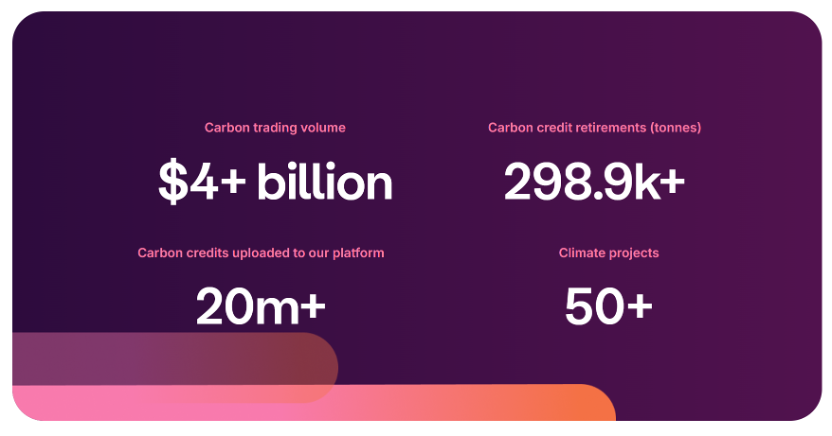
Source: https://toucan.earth/
The carbon stack of Toucan tokens consists of three modules:
Carbon Token Bridge.
Carbon Token Pools: Pools similar carbon credits together to create a more liquid market and more transparent price signals for various carbon categories.
Toucan Token Registry, which stores detailed information about fragmented carbon, such as project-specific information and the exit of carbon credits.
To transfer carbon credits from a traditional registry to the Toucan token registry, individuals need to exit their credits in the original registry to prevent double counting. Once the link is completed, carbon credits can be split into TC02 tokens—where T stands for "Toucan," "Tonne," or "Tokenized," and C02 represents carbon dioxide.
However, there are still many disagreements regarding the tokenization of carbon credits. Some stakeholders are concerned that tokenized carbon credits may be used by bad actors to deceive buyers into purchasing low-integrity credits, or that carbon tokens may be used to make false offset claims. Another controversy is that tokenization provides a second life for "non-additional" credits. For example, if a conservation project protects a forest that was not at risk of being destroyed, then the project does not actually reduce carbon emissions. In this case, the carbon credits generated are referred to as "non-additional" because they do not provide additional environmental benefits.
6. Art and Collectibles Tokenization: Crypto Punks Spark a Wave of Collectibles Tokenization
The potential impact of RWA tokenization on the art and collectibles market is enormous. By enabling fractional ownership, tokenization makes it easier for a broader range of investors to access high-value assets. Currently, the art world has witnessed several successful cases of tokenizing famous artworks, significantly impacting the art market by making it more inclusive and vibrant. For example, Syngu Bank tokenized Pablo Picasso's 1964 masterpiece "Girl with a Beret," allowing 50 investors to purchase 4,000 tokens representing fractional ownership of the artwork. Beeple's digital artwork "Everydays: The First 5000 Days" sold for $69.3 million at Christie's auction house, making headlines and setting a new precedent for tokenized digital art.
Tokenization has also made significant strides in the collectibles market, most notably with the Crypto Punks tokens, a collection of 10,000 unique digital characters created by Larva Labs. Each character is an NFT token on the Ethereum blockchain, with some characters selling for millions of dollars. This success has sparked the tokenization of both physical and digital collectibles, showcasing the potential of blockchain technology in this field.
Figure 23: The Collection of 10,000 Unique Digital Characters of Crypto Punks
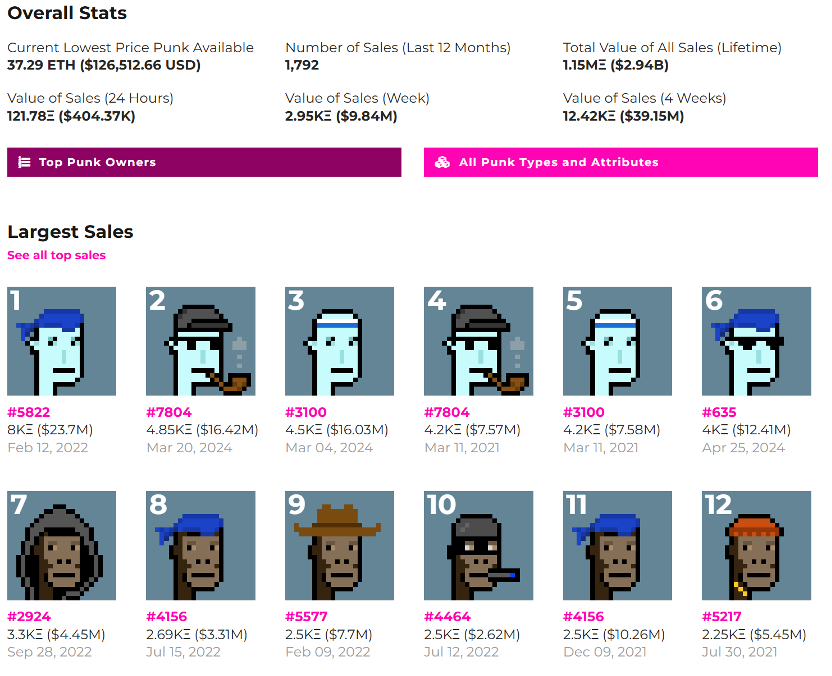
Source: https://cryptopunks.app/
While the tokenization of art and collectibles offers countless opportunities, it also comes with considerable challenges and regulatory issues. First, although it provides global market coverage, the volatility of the cryptocurrency and NFT markets can lead to significant fluctuations in value, making these investments highly speculative. Additionally, there is a conflict between investors' demand for privacy and regulators' requirements for transparency and auditability: investors wish to protect their identities and transaction information, while regulators emphasize the need for transparent transaction records to prevent fraud and money laundering. Navigating the complex legal and regulatory environment and establishing a fair and transparent valuation mechanism is crucial for the long-term success and stability of the tokenized art market.
7. Precious Metals: PAXG Addresses Common Challenges in Traditional Gold Investment
Similar to securities tokens, there is also a demand for trading precious metals (such as gold) on-chain, which is one direction for synthetic asset projects. In reality, there are projects backed by real precious metals that issue tokens on-chain, such as Paxos's PAX Gold (PAXG).
Typically, ownership of gold can be very complex, as the costs of transporting and storing physical gold bars can be high due to their size and weight. Buying and selling gold reliably is also challenging—counterfeiting and purity dilution pose ongoing challenges to the gold industry. Paxos's cryptocurrency Pax Gold (PAXG) aims to address these challenges.
Each PAXG token is backed by one ounce of 400-ounce London Good Delivery gold bars, which are securely stored in Brink's vaults. Users can exchange PAXG for full-sized gold bars or smaller amounts through various partner retailers, making it a highly liquid asset. Additionally, Paxos does not charge storage fees for PAXG, resulting in lower transaction costs compared to traditional gold investments (such as ETFs or physical gold purchases).
Figure 24: The Collection of 10,000 Unique Digital Characters of Crypto Punks
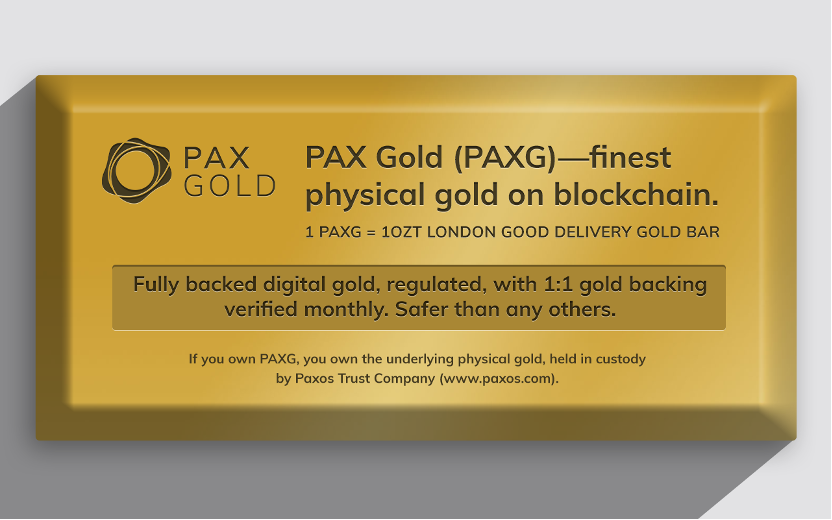
Source: https://paxos.com/blog/14/
Pax Gold represents a significant innovation in how individuals invest in gold. By addressing common challenges in traditional gold investment (such as high costs, poor liquidity, and complex ownership structures), the PAXG token provides a modern solution that attracts both retail and institutional investors seeking to invest in gold.
IV. Is the Narrative of RWA Too Optimistic?
Given the numerous benefits of tokenization, one naturally wonders: why has the industry not eagerly adopted it?
This is because, despite the bright future of RWA tokens, the industry still faces many resistances and challenges, some of which may be more severe than others and may take longer to overcome. This article believes that the tokenization of RWA will eventually consume traditional finance, but it is still necessary to recognize these potential barriers to understand the factors hindering large-scale adoption.
1. Regulatory and Compliance Issues
Like all financial innovations, the tokenization of RWA must operate within an established legal framework to ensure its legality and sustainability.
First, compliance is not just a matter of simply adhering to laws; it also concerns building trust with investors and stakeholders. In the absence of clear regulatory guidelines, tokenized assets may fall into a quagmire of legal uncertainty. For most regions globally, regulators have yet to provide specific guidelines for RWA, so regulatory actions may negatively impact existing RWA participants and the entire industry.
In terms of legal recognition, tokenized assets must have the same legal effect as assets in the real world. This means that the ownership, liabilities, and protections of tokenized assets should align with traditional legal frameworks. However, without proper regulatory coordination, the ownership of tokenized assets may face risks of difficult court enforcement or lack of recognition in certain jurisdictions.
Moreover, there are significant differences in the regulation of financial assets, real estate, and securities across countries, posing enormous challenges for compliance across multiple jurisdictions. The lack of a standardized legal framework further exacerbates the complexity of global coordination and may lead to potential legal conflicts or uncertainties.
2. Underlying Blockchain Technology
RWA projects face multiple technical challenges in their advancement. First, the blockchain technology architecture requires market participants to connect to DLT (Distributed Ledger Technology) nodes; however, establishing and managing DLT nodes is not only costly but also technically demanding, requiring substantial support in infrastructure development, making it difficult for many market participants to adapt.
Second, the underlying blockchain technology itself is continuously being optimized, with cryptographic algorithms, smart contracts, consensus mechanisms, etc., still evolving. Although underlying blockchains typically remain secure, decentralized finance (DeFi) protocols may still be vulnerable to hacking. Therefore, project teams need to keep up with technological developments to ensure the security and stability of the tokenization process.
The issue of technical standardization is also a significant challenge faced by RWA projects. Due to different programming conditions across blockchains, there are interoperability issues between different blockchains, and there is a lack of a unified language or protocol rules between asset networks. For example, in recent years, many commercial tokenization platforms have emerged, operating on their respective (often private) DLT networks, which can lead to fragmentation in product markets and funding pools. Therefore, standardization between blockchain and real-world asset platforms becomes particularly necessary. However, it is important to note that solutions to interoperability issues, such as cross-chain bridges and communication channels, may become points of vulnerability, leading to data manipulation or false representations of asset values.
3. Distinguishing Hype from Reality
With the rapid expansion of tokenization projects, a clear issue has gradually emerged: the fervent pursuit of blockchain technology often overshadows the focus on actual solutions and real benefit needs.
Many tokenization projects focus more on the allure of blockchain itself, failing to fully understand how it can effectively meet specific market needs or solve real problems. Although the concept of tokenization sounds innovative, these projects often lack depth and struggle to justify why asset tokenization is superior to traditional methods.
More seriously, in order to ride the blockchain wave, many projects overly emphasize marketing and speculation, with some projects created purely to cater to the popularity of blockchain and tokenization, often lacking a solid business plan or strategy, and failing to provide real value to investors and users. They may generate excitement among the public by heavily promoting tokenization as cutting-edge technology but fail to deliver tangible benefits such as increased efficiency, enhanced transparency, or expanded accessibility, areas where traditional systems may still hold advantages.
4. Security Issues
The tokenization of Real World Assets (RWA) introduces various security issues that could severely impact its viability and credibility in the market. First, although information can be shared on-chain and updated regularly at zero cost, inconsistencies between on-chain data and off-chain asset states still exist, which may lead to the risk of accounting fraud, providing opportunities for bad actors.
Second, security vulnerabilities in smart contracts are also a significant challenge faced by RWA projects. Once deployed, smart contracts are difficult to modify, so they must be designed and implemented with great caution. However, coding errors, logical flaws, or unverified external inputs can lead to malicious attacks on smart contracts, resulting in asset loss or system paralysis.
Transferring RWAs to the blockchain also brings risks related to account and private key theft. If an attacker learns a user's private key and tricks them into digitally signing a malicious transaction, the ownership of the RWA may be transferred to the attacker without the owner's authorization. If these keys are lost or stolen, the associated assets will be unrecoverable.
In summary, the process of large-scale application of RWA is fraught with obstacles such as regulatory, valuation, and technological risks. However, these issues are not insurmountable: ComPilot is addressing these regulatory challenges with comprehensive KYC solutions; Chainlink's Cross-Chain Interoperability Protocol (CCIP) enables RWAs to transfer seamlessly across different blockchain networks; integrating decentralized oracles can provide real-time data feeds to help distinguish between different quality RWA projects. However, as with many other new technologies, a sufficient number of people must adopt the relevant technology to fully realize its benefits. Therefore, public institutions, including monetary authorities, could play a demonstrative and coordinating role in encouraging industry adoption.
Conclusion
The tokenization of real-world assets will be a killer application leading blockchain to a scale of trillions, with its potential likely to impact the entire financial and monetary system of humanity. At this stage, for the crypto world, the logic of RWA tokens is a one-sided demand for the returns of real-world assets, while the true potential of tokenization can be realized in the traditional financial world. The logic of RWA for TradFi is a bidirectional journey, where the traditional financial world needs blockchain and token DeFi technology as a new fintech tool to empower the traditional financial system.
Achieving large-scale application of real-world asset tokenization requires legal regulatory compliance as one of the necessary prerequisites, ensuring the legal validity and protection of tokenized assets is key to achieving market recognition; to meet the regulatory and asset risk management demands of regulators and financial institutions, interoperability between blockchains and the security of information transmission are particularly important. As new-generation cross-chain technologies like CCIP gradually improve, the future multi-chain landscape is laying a solid foundation for the large-scale application of RWA.
As the barriers to the large-scale application of RWA projects are overcome, we can envision a future where people can easily own and manage their tokenized assets, seamlessly completing transactions in daily life using wallets and on-chain fiat currencies. On-chain fiat currencies open a new door for the promotion of tokenization technology in practical application scenarios, providing broader application space and practical value.
免责声明:本文章仅代表作者个人观点,不代表本平台的立场和观点。本文章仅供信息分享,不构成对任何人的任何投资建议。用户与作者之间的任何争议,与本平台无关。如网页中刊载的文章或图片涉及侵权,请提供相关的权利证明和身份证明发送邮件到support@aicoin.com,本平台相关工作人员将会进行核查。




